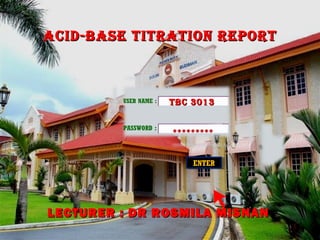
Lab acid titrate
- 1. ACid-BAse TiTrATion reporT USER NAME : TBC 3013 ********* PASSWORD : ENTER ENTER LECTURER : DR ROSMILA MISNAN
- 2. GROUP MEMBERS NAME MATRIC NO. UMI ABIBAH BT SULAIMAN D20091034811 SITI RAHAYU BT MOHAMED NOOR D20091034855 D20091034872 NUR AFIQAH BINTI MUHAMAD APANDI D20091034814 AMEERA BT YAHYA
- 3. ABSTRACT The main objective of this study was to investigate the property of weak acid with pH changes. Result was collected from the pH meter during the titration of acetic acid and phosphoric acid with 1mL of 0.1M NaOH . The graph pH against volume of NaOH is plotted and the pKa value was determined. Both acid have different pKa value and horizontal part of the curve. The study recommends that the larger the value of pKa, the smaller the extent of dissociation while the smaller the pKa value the higher the extent of dissociation.
- 4. INTRODUCTION Titration laboratory method of quantitative analysis used to determine unknown concentration of known substance. Pka value can determined pKa of an acid from the graph. value used to describe the tendency of compounds or ions to dissociate. This allows the proportion of neutral and charged species at any pH to be calculated, as well as the basic or acidic properties of the compound to be defined.
- 5. METHOD: ACID BASE TITRATION
- 6. METHOD : ACID BASE TITRATION Titration apparatus Calibrated pH meter
- 8. Table : Volume of NaOH used and the pH values recorded
- 9. RESULT
- 10. Graf 1: pH vs Volume of NaoH (Acetic Acid) pKa1=5.52
- 11. To calculate the acid dissociation constant (pKa), one must find the volume at the half-equivalence point, that is where half the amount of titrant has been added to form the next compound. From the graph plotted the pKa for acetic acid is 5.52 compare to the theoretical value which is 4.76. Halfway between each equivalence point, at 4 mL ,the pH observed was about 5.52 , giving the pKa.
- 12. Graf 2: pH vs Volume of NaoH (Phosphoric Acid) pKa3=12.24 pKa2=7.44 pKa1=3.21
- 13. Then, the pKa value for phosphorus acid accoding to the graph are 3.21,7.44 and 12.24 compare to the theoretical value which are 2.15,7.20 and 12.35. Halfway between each equivalence point, at 4 mL , 12.5 mL and 19.5, the pH observed was about 3.21, 7.44 and 12.24 , giving the pKa.
- 14. The pKa from the experiment result was not too accurate compare to the theoretical value. This might be happened because of: Not precisely added pH meter used also 1ml of 0.1M NaOH not too suitable and for every step not measured the titration process. accurate pH reading.
- 15. The pKa of an acid can be determined from the part of the graph having flat or more horizontal part of the curve. The larger the value of pKa, the smaller the extent of dissociation while the smaller the pKa value the higher the extent of dissociation.
- 16. For acetic acid one horizontal part on the curve For phosphoric acid three horizontal parts The difference arise Due to acids having one or more than one dissociation constant in order for all the H+ ions can react completely with the OH- ions being added during the titration process.
- 17. CONCLUSION As a conclusion, able to identidy the pKa of an acid by using titration. learn how to use pH meter correctly.
- 18. REFERENCES https://docs.google.com/viewer? a=v&q=cache:hWqGYixWkLsJ:www2.chem.ubc.ca/courseware/330/pKa.pd f+&hl=en&gl=my&pid=bl&srcid=ADGEESi0c85vsFbBU4uwyfTNi2oMOBB8 prpi05jtfiPOheSrjLORUpXTvhvoLAAALjoQweS1utzrEGWeJkbUGBuwsix CBSHf3ULXuzjHyDGhG4MAQNjL86hdoGlCTWzD0Hc6v12ZMAI0&sig= AHIEtbTBuPkVBPk4IcMmhHj7n0u1hNGnXw https://docs.google.com/viewer? a=v&q=cache:oOMX3c6_bfoJ:www.deltacollege.edu/emp/ckim/Labs_PDF/ AcidBaseTitrationCurveLab.pdf+&hl=en&gl=my&pid=bl&srcid=ADGEESjl3 hlEXLOO2UI_DXZGy35s8xAPURLrBVvoCgc7WH8O1lWP4yTZuSvdNh oEgwdMKoVoXJsSIFhktON_PWOttJPKukddWLfQGe7UChJESb0bPka_sP mk81gIvaAQE8o7lrIa1CAl&sig=AHIEtbRprjL5NExSdDjM_UtF5F-LJ4hdvQ
- 19. THANK YOU!!!!
